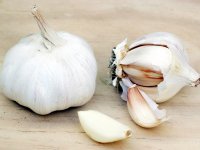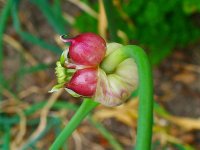Garlic - allium sativum
Family Onions (Alliaceae).
Botanical characteristics. Perennial herbaceous plant. The bulb is oval-cordate, consists of several (sometimes up to 30) small onion-pups, clad in one coat. Stem up to 1 m high, straight. Leaves are radical, wide-linear, long. The flowers are plain, greenish-white, collected in the inflorescence - an umbrella. Blooms in July-August. Instead of fruits on the tip of the stem, small air bulbs are formed, serving for the vegetative reproduction of garlic.
Spread. One of the oldest cultivated plants, popular with the Sumerians, in Egypt and in ancient Rome. It is believed that cultural garlic originated from a wild Central Asian ancestor. Currently, it is widely distributed in all regions of the country as a garden crop.
Used parts of the plant. Bulbs and leaves.
The characteristic taste and smell of garlic is determined by an essential oil consisting of sulfur compounds. Contains nitrogenous substances, glycoside amine, phytosterols, metal salts, vitamins C and B vitamins.
Application of garlic in medicine
It is widely used as a vegetable plant and at the same time is a medicinal plant in folk and scientific medicine.
Garlic slightly lowers blood pressure, normalizes metabolism, helps to remove excess cholesterol from the body and is used to prevent and treat hypertension and atherosclerosis.
Bulbs and green leaves improve digestion and excite appetite, act spasmolytic in gastrointestinal colic, flatulence and chronic enterocolitis. Garlic strengthens diuresis, is used for kidney and bladder diseases, kidney stone disease, prostate adenoma.
In folk medicine it is used in many diseases: with impotence, as an antihelminthic agent in combination with garlic enemas; As an antitumor agent; With amenorrhea, beriberi, chronic skin diseases.
The strong bactericidal effect of garlic caused by phytoncides is well known. Garlic is taken with various infectious and febrile illnesses with a curative and preventive purpose: with influenza, angina, dysentery, etc.
Outer in the form of gruel, juice, ointment and water infusions from bulbs and leaves are used to treat sluggish healing wounds, sore throat and cold, trichomonas colpitis, pyoderma, scaly lichen, seborrhea, warts, calluses.
Contraindications. May cause irritation to the gastrointestinal tract, kidneys and liver. Patients who are not accustomed to garlic should take it with caution, starting with small amounts (1-2 teeth per day).
Cooking and using garlic
- Drugstores: Garlic is a part of allochol tablets, is used for chronic hepatitis , cholecystitis and constipation.
- In gastrointestinal diseases, one to three cloves of garlic are eaten.
- Enema is prepared from the calculation of 5 to 6 teeth (finely chopped) on a glass of warm water.
- Grated garlic in the form of gruel is used as an external agent for oily seborrhea and hair loss .
- Infusion of garlic: 2-3 cloves of finely chopped garlic pour a glass of boiling water. After 40-60 minutes, the infusion is used as an external agent: buried in the nose, rinsing the throat, doing lotion and syringing.
- Tincture of bulbs of garlic: 7 - 10 g of garlic ground, pour vodka (0.5 liters). Insist a week in a warm place. Used for rubbing in myositis, neuralgia in patients with diabetes mellitus.
- Decoction of bulbs of garlic: 1 tbsp. L. Crushed cloves of garlic pour a glass of boiling water, boil for a minute with the lid closed and insist for half an hour. Filter and drink for 1 - 2 tbsp. L. 3 times a day after meals, mainly with chronic cholecystitis.
- Infusion of garlic: 5 g of crushed garlic cloves insist on a glass of milk for 30 minutes. They are used as a lotion for purulent ulcers, panarits or for an enema with hemorrhoids. It is used for syringing with genital itching in diabetics.
- Garlic Ointment: Make a gruel from 10 to 12 g of garlic, mix it with 20 g of duck or goose fat, thoroughly grinding in a mortar. They are used as rubbing for articular and neuralgic pains.
- There is an old way of treating garlic toothache. With pain, the wrist of the hand on the backside is rubbed with garlic (hand opposite to the sore side), then cover the wrist with a thin cotton cloth. Finely chopped garlic is put on a rag. Tightly bandage your hand to the garlic tightly to the wrist, especially to the pulse area. After a while (20-30 minutes) the toothache passes, if it is, of course, not a purulent inflammation of the periosteum. For more than 30 minutes, garlic should not be kept, as there can be a skin burn.
Garlic in the garden
Garlic is an effective remedy against many pests of garden and fruit-berry crops: mites, aphids, fungal and viral diseases, slugs, ants, beeswax, worms, hruschaks, etc.
Instead of using pesticides on your own garden site, which eventually end up in the stomach for you and your children, use garlic or other green insecticides to treat the plants (aconite, celandine, ledum, hemlock, onion, yarrow, delphinium, Tomatoes, potato, dandelion, tansy, juniper, nightshade, cauliflower, etc., or mixtures of these plants).
Infusion of garlic is prepared as follows: 300 g of garlic finely cut, pour 2-3 liters of water and bring to a boil. Immediately turn off the fire, cover with a cloth and insist for 2-3 hours or night. Then the infusion is filtered and diluted with water to 10 liters (before the bucket). This infusion is sprayed sick plants or healthy, as well as the land around them - for the prevention of disease.
It is better to spray not from a watering can, but a usual broom. This spraying is carried out 2 - 3 times a season or more often - if there is a need. All cultivated plants, even roses, tolerate the infusion of garlic. Already the next morning after spraying you can see how birds run around under bushes and collect insects (and what will become of birds if instead of garlic splashing shrubs carbofos?).
Homeopathy. In homeopathy apply Allium sativum 3 x, 3 for allergic reactions, polyposis, bronchial asthma and adenovirus infections.






Comments
When commenting on, remember that the content and tone of your message can hurt the feelings of real people, show respect and tolerance to your interlocutors even if you do not share their opinion, your behavior in the conditions of freedom of expression and anonymity provided by the Internet, changes Not only virtual, but also the real world. All comments are hidden from the index, spam is controlled.